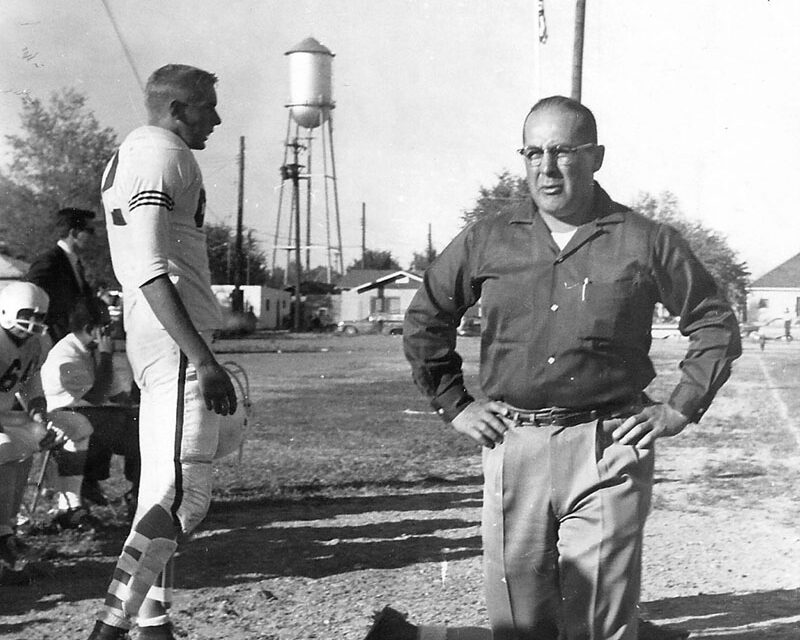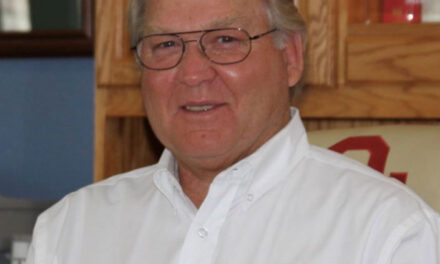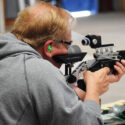Evisalio “Bull” Padilla cannot remember a time in his life when he didn’t love sports. As a boy at Belen’s Eastside School, he went to all the basketball games at Belen High School, although he was so young that he was afraid of the dark and ran the whole way home, including over the viaduct.
His teacher, Frank Baca, let him leave school early to go to high school football games. He also went to watch the team practice, although a coach once ran him off for getting in the way.
The coach that ran Bull off the field could not have known that that little boy would grow up to be a star football player at BHS, a starting lineman at New Mexico Highlands University and one of the greatest coaches Belen has ever known.
This is the story of how a self-described “runt” accomplished all this in his athletic career while influencing countless lives in the town he loves most, Belen.
Getting started in life
Born in La Joya in 1931, Evisalio Padilla was the youngest of three boys. In 1937, Evisalio’s parents, Sesario and Praxedes Griego Padilla, moved their family from La Joya to Eastside School Road because Sesario worked for the Santa Fe railroad and it was more convenient for him to live closer to the railroad yards in Belen.
Genealogist Francisco Sisneros has documented that Evisalio’s family is one of the few New Mexico families that can trace their histories directly to Spain with 99 percent certainty. Evisalio’s ancestors immigrated to New Spain (now Mexico) in the 1570s. The Padilla family remained in or near Mexico City for five generations, or until about 1669 when Captain Jose de Padilla arrived in what is now southern New Mexico.
The Padilla family became increasingly influential after the reconquest of New Mexico in the 1690s. By the mid 18th century the family had arrived in central New Mexico, marrying into families in communities such as Tomé and Belen and eventually settling in La Joya in 1800 when it was founded. Not many New Mexicans can document their genealogies back 13 generations with great confidence.
Getting started in sports
Frank Baca, Evisalio’s teacher at Eastside School, must have noticed something special about Evisalio and his interest in sports when he allowed Evisalio to attend BHS football games on Friday afternoons.
Good teachers recognize and encourage students who have particular interests. Frank Baca did that for Evisalio and Evisalio would do the same for hundreds of his own students, including Frank Baca’s youngest son, Louie.
Evisalio was eager to join the football team when he entered Belen High School as a freshman in 1946. He reported to practice, was issued a uniform and worked hard until school started that fall. On the first day of classes, he went to the locker room and discovered that his uniform was gone. Asking what had happened to it, he was told that his uniform had been assigned to an upperclassman and he was off the team.
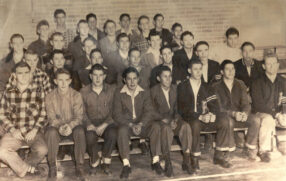
Evisalio Padilla, seated, fourth from left, with fellow members of the Belen High School Varsity Club, 1948.
Photos courtesy of Evisalio Padilla
But everything changed in Evisalio’s sophomore year. Belen High hired three new coaches with fresh ideas and new attitudes. Veterans of the recently-ended world war, Dan Miranda, George Johnson and Abbie Paiz were determined to transform Belen from a small-town program into a high school football powerhouse.
As if to discard the past and launch the future, Coach Miranda burned all the team’s old football uniforms in a bon fire and notified the superintendent of schools, Adelino Sanchez, that his team needed new uniforms for the new season.
Belen’s new coaches made other important changes. To instill pride in their players, the coaches created Belen’s first Varsity Club; Evisalio was among the club’s first members. The football team had always played seven games in a limited schedule against the same teams each season. Knowing that competition would bring out their players’ best skills, the coaches expanded the team’s schedule to 11 games, to include games against new rivals, such as Hot Springs. The Eagles played Hot Springs on Thanksgiving Day 1948 and, although they didn’t win, they showed that Belen was a team to be reckoned with in the future.
Coach Johnson also improved his football team by insisting on strict discipline on and off the field. Before his arrival in Belen, players got away with almost everything, including going deer hunting in the middle of the football season.
When his starting guard went hunting one weekend during the football season, he returned on Monday to find his uniform gone. He and his fellow players learned that their team must be their top priority or they couldn’t be on the team at all.
With Evisalio playing offensive and defensive tackle, the Eagles began to win game after game. Evisalio remembers a contest in Raton when the Eagles scored a touchdown. A zealous Raton fan yelled, “If you think you’re so good, try to score another!” The Eagles did, winning the game 33-0.
In 1948, they scored 100 points in the course of two games, against Estancia and Mountainair; their opponents never scored. With Evisalio as their co-captain, the Eagles won 13 games, lost 7, and tied two in 1948 and 1949.
It was during these glory days of high school that Evisalio was given the nickname “Bull.” Evisalio suspects that Coach Johnson might have called him Bull because he could not pronounce Evisalio correctly. It’s more likely that Coach Johnson chose this nickname because Bull is a name given to football players as a sign of admiration and respect.
Players nicknamed Bull played with all the courage and determination of a bull. Although an undersized “bull” at 5-foot, 6-inches tall and 180 pounds, no one doubted that Evisalio deserved the nickname because he always charged straight ahead and never backed down from a tackle, no matter how large his opponent.
Playing college ball
When not practicing or winning games, Evisalio and his friends often met at the B&B Café in Belen. The boys were sitting in the café one day in 1950 when Coach Miranda walked in and asked Evisalio where he’d like to play college football after graduation.
The next day, the coach accompanied Evisalio to Las Vegas and arranged for Evisalio not only to play for the New Mexico Highlands University football team, but also to receive a scholarship and land a job. Coach Miranda had joined Frank Baca in recognizing Evisalio’s interest and skills, encouraging him to take another step forward in his football career.
Evisalio played guard at Highlands University. The competition was rough when he started in the fall of 1950. About a 100 students tried out for the team, including many Easterners and many vets just back from World War II. Despite his comparatively small stature, Evisalio thrived on the competition, starting as a sixth-string lineman and becoming the team’s starting offensive and defensive guard. He was, in fact, the team’s only freshman starter.
Evisalio enjoyed his years at Highlands, making friends and improving his football skills. He doesn’t recall much hazing, although he does remember new players being blindfolded and pied with limburger cheese.
Tragically, Evisalio tore a cartilage during his junior season, but completed the year by playing through his injury. His knee was healing rather well when he re-injured it during a gymnastics class in the summer of 1953. He underwent an operation, but could not play in his senior year.
He graduated with a degree in physical education and Spanish in December 1953. He earned a master’s degree in physical education and recreation from Highlands in 1958.
Heading home to Belen
After teaching at Grants High School in the spring of 1954, Evisalio enlisted in the U.S. Army. He served at Ft. Bliss, Texas; at Ft. Lewis, Washington; and in Korea in the aftermath of the Korean War. He didn’t play football in the Army, but did serve under Capt. Roger Franz, a former star quarterback at Fordham University, who had led the nation in passing yards in 1953.
The two former college players got along well. Evisalio was honorably discharged in March 1956.
Leaving the Army after his two-year stint, Evisalio’s primary goal was to return to Belen and become a coach. Fortunately, he achieved his goal, teaching P.E. full-time and joining the high school’s coaching staff in 1956. He served as the assistant coach of the baseball and basketball teams.
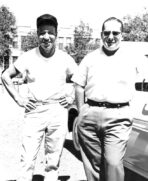
Coaches Bull Padilla and Abbie Paiz.
Coaches had a lot of different responsibilities in those days, including driving their team buses to away games. Coach Padilla let it be known that his players had to be on time for the bus or they’d be left behind. One day, a player was late for a game in Socorro. Coach Padilla left the player behind. Just to show he meant business, he left a first-string player behind when he missed the bus, too.
Evisalio enjoyed coaching other sports, but his goal had always been to coach the varsity football team at Belen High. His big chance came in 1962 when he was only 30 years old. He said he had a good crop of players, but he also had a lot to learn about his new job and its responsibilities.
Coach Padilla remembers that although he strove to be strict and fair in his first year of coaching, things did not go well early in the season. Everything changed one October afternoon.
Upset by the way his team was practicing, the coach told his assistants to have the players run laps and just go home. As he walked off, Bull suddenly realized that having the players run laps and go home was not a punishment for practicing poorly, but exactly what many of them had hoped for — a chance to go home early. The coach turned around, had his players run more laps and worked them hard the rest of the afternoon. Things improved after that incident. The Eagles beat two of their rivals, St. Mary’s and Los Alamos, by the same 28-0 scores.
As the years progressed, Coach Padilla developed his teams by identifying potential football players in his P.E. classes and in Belen’s summer recreation program. The coach believed a major part of his job was to recruit and develop new players, not just wait for good players to come along.
In his words, “I’d rather lose with the right boys than win with the wrong ones.”
Dr. Jose Rivas also helped identify potentially good players when he gave students their school physicals from grammar school on. A former football player, the doctor claimed to be able to spot boys who might kick well just by seeing how they walked. He was often right, as in the case of two great kickers, Kent Seery and George Trujeque.
Dr. Rivas served as the team’s unofficial team doctor. The doctor and his family went to every game, both home and away, and Rivas was always there to help if a player was injured. Long before there was protocol for dealing with concussions and injuries, Dr. Rivas would evaluate whether or not a player was well enough to get back in a game.
Rivalries & championship game
When asked what teams were his teams’ greatest rivals, Coach Padilla started naming them off and then realized that almost every team the Eagles played had become a rival over the years. There was of course their arch rival, Los Lunas, but there were also Hot Springs, Gallup, Grants, Socorro, Anthony and Los Alamos, to name a few.
Of course, the Eagles’ most famous game under Coach Padilla’s leadership came at the end of 1963, his second season at the helm. That was the season when Belen’s front line consisted of big, talented players such as Sam Chavez, Gene Bustamante, Randy Trembly, George Trujeque and Rex Henington.
In the days when players played both offense and defense, a newspaper in Las Vegas praised the Eagles for their “fine blocking” and “fast moving” skills. Most of their linemen outweighed their opponents by 25 to 30 pounds. With a split T running offense, the Eagles ran up large scores behind quarterback Emilio Vallez and halfback Danny Aragon.
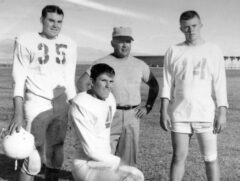
Coach Padilla with players Bobby Barton, Michael Sanchez and Keith McDonald, 1968.
The Eagles went undefeated during the regular 1963 season, gaining momentum from game to game. They were like a running back gaining speed on a long touchdown run with no one coming close to tackling him. They crushed the Socorro Warriors 38-0 and beat the powerful Los Alamos Hilltoppers by scores of 21-15 and 26-6. They also beat Los Lunas in Belen’s homecoming game in a “rough contest” filled with penalties, according to the Albuquerque Journal. Final score: 14-6.
Undefeated and untied, Belen headed into the Class A championship game against the New Mexico Military Institute (NMMI). In their first year of high school conference play, the cadets were also undefeated, but had tied two games. They were led by their star running back, Paul Arnold (with 34 touchdowns) and their record-setting place kicker, Pete Johnstone.
One of the most famous games in Belen football history was played before a crowd of 2,500 fans in Roswell on Saturday, Nov. 30, 1963. Coach Padilla had prepared his team for a defensive battle and that’s what they faced. By halftime, only Pete Johnstone had scored with a 24-yard field goal. Otherwise each team had the exact same number of offensive yards — 93. The Eagles had held Paul Arnold scoreless.
The second half was much like the first. Belen threatened to score twice, only to be pushed back with two costly penalties. As the final minutes ticked away, the battling rivals were even in nearly every statistic except the one that counted the most. NMMI beat Belen 3-0. Coach still believes his team should have won that game.
Belen lost the Class A championship in 1963, but won nearly every individual honor awarded that season. Rex Henington was named the Class A defensive player of the year, while he and three of his senior teammates, Kent Seery, George Trujeque and Emilio Vallez, were chosen for the Class A All-State football team. Most deservedly, Bull Padilla was named the Class A Coach of the Year.
Bull Padilla coached varsity football in Belen for a decade, from 1962 to 1971. His teams had many great individual games and win-loss records, including 8-2 in 1966. Without exception, his players remember him fondly to this day. The consensus is that the coach was always tough, but always fair. Some considered him a second father.
Remembering what Frank Baca and Coach Miranda had done for him, he treated every player the same way and taught everyone that they could do anything they set their minds to. Many wonder why the Eagles’ football field or stadium has not been named in his honor. No one can deny that as a player and a coach, Bull Padilla put Belen on the map in New Mexico football.
Best players?
When asked who his best football players were, Coach Padilla remembers many great players but would rather not identify any one boy as his best. This is completely in keeping with his goal of letting as many boys as possible play football and learn from the experience.
Coach Padilla would rather list his players’ later accomplishments than list their individual names. Many went to college and played college ball at schools such as the University of New Mexico, the University of Wisconsin, New Mexico Highlands University and Western New Mexico University. A good many enjoyed successful careers in professions such as teaching, coaching, medicine, business and engineering. Some remained in New Mexico, while others have lived and worked as far away as the Middle East.
Coach Padilla worked with his best players, but also with boys who needed help but didn’t always ask for it. John Williams, for example, lived at the Boys Ranch while attending Belen High and playing basketball and running track in the 1950s. Coach Padilla noticed John used a pay phone to call the ranch for a ride home after the team returned from away games. Rather than make John wait outside in all kinds of weather, Coach Padilla or assistant coach Tony Galaz would drive John home to the ranch.
Coach Padilla remembers other athletes from the Boys Ranch, including Larry Trepland. Larry was a very popular student and an excellent running back. Coach remembers a particular game against Belen’s arch rival, the Los Lunas Tigers. The Eagles enjoyed a comfortable lead and were playing out the clock when Larry got the ball and ran for a long touchdown. An All-District player in his junior year, Larry showed all the signs of becoming a top recruit for a major college football team.
Coach Padilla and the entire town of Belen were shocked when Larry died after undergoing a simple tonsillectomy in his junior year. Larry’s death in 1972 was one of Belen’s greatest tragedies. Coach Padilla remembers that so many people attended Larry’s service at the Belen High School gym that the building was filled to capacity.
Larry was buried in Alamogordo, his family’s hometown. His friends from Belen have recently installed a head stone with an image of Larry in his football uniform and the words, “Fast as Lightning.”
Rare bumps in the road
Coach Padilla enjoyed great success in his 10 years as a head football coach. But, as in every career, especially as long as his, there were rare bumps in the road. He can only recall one example of what might be construed as racism.
Shortly after joining the high school’s coaching staff, he received an anonymous letter with the words, “We don’t need any more of your kind in Belen.” Coach Abbie Paiz wisely counseled Bull to ignore the letter. Coach Padilla followed Paiz’s sage advice.
Coach Padilla only remembers a few incidents of misbehavior by his players. Most boys respected him too much to cause trouble. But some kids still engaged in mischief.
On one bus trip to Ft. Sumner, the coach was sitting behind the bus driver, assistant coach Nick Sanchez, when a player threw an orange peel at Coach Padilla’s head. The peel missed its target, but hit the bus’s windshield.
Coach Padilla didn’t say anything until the bus got to the bottom of a steep hill. Bull told Coach Sanchez to stop at the foot of the hill and told his players to get out and run to the top. He never found out who threw the orange peel, but he knew that whoever it was, was punished by their coach and, no doubt, by his fellow players who had to run up that hill with him.
On another occasion, Coach Padilla decided to start a new quarterback. Not agreeing with the move, a few seniors let their disapproval be known. Rather than remove his new quarterback, the coach brought the disgruntled seniors together and told them how much they were going to be missed the following year when they graduated. He also told them that if their attitudes did not improve soon “we’re going to miss you much sooner.”
Coach Padilla taught drivers education each summer. Most of his students were in high school but some were women from the community who had not yet learned to drive. To this day, grateful students say they passed their drivers’ test and can parallel park thanks to the coach’s kind, patient teaching.
Coach Padilla remembers his drivers ed students fondly, except for a senior student who stopped the drivers ed car in the middle of Main Street and a group of students who were so cocky that he wished he could have dropped them off in far-off Bernardo.
I wondered if Coach Padilla ever got into any trouble of his own making. He didn’t take long to recall the day he almost lost his job when he failed to attend a pep rally held before a home game in Belen. Never seeing the value of pep rallies for his players or his staff, the coach simply went to the field to prepare for the upcoming game.
Dissatisfied with his behavior, the administration asked for his letter of resignation by the end of the day. After a few tense hours, cooler heads prevailed when Coach Padilla agreed to attend future pep rallies and Belen High School withdrew its hasty request for his resignation.
Measuring success
When asked the secret of his success as a head coach, Coach Padilla says that it was no secret at all. He simply inspired a positive attitude, surrounded himself with good people and maintained good discipline.
Regarding a positive attitude, Coach Padilla said that 75 percent of a football team’s success comes from creating good team chemistry, with a good program that players buy into wholeheartedly.
Coach Padilla also surrounded himself with good people, including great assistants, good players, cooperative parents and supportive administrators such as A.J. Garde, the superintendent of schools, and Belen High School principal Russell Ashbrook.
The appreciative coach remembers the names of his first assistants — Tony Galaz, Buddy Robertson and Nick Sanchez — his last assistants — Beltran Sedillo, Jim Burke, Kenny Griego and Jimmy Danner — and everyone in between.
Most of all, Coach Padilla gives credit to his wife, Eva. Marrying in 1964, the couple raised two girls, Mary Frances and Patricia, and two boys, Armando and Mario. A former teacher, Eva appreciated the value of sports and the challenges of being a coach. She attended all of Coach Padilla’s games, both home and away, often with assistant coach Jim Burke’s wife, Sue, at her side. Coach Padilla remembers Eva as the perfect coach’s wife: patient, understanding, supportive and, above all, loving.
Coach Padilla has noticed that Belen’s best coaches and assistants have often grown up in Belen, graduated from Belen High School and chosen to live in the Belen community with their families. The coach knows that he could have used his success in Belen as a stepping stone to jobs in California, where he could have made more money and coached in bigger schools.
But that was not his idea of a successful career. Success was not about a lot of money, fame, wins or even championships. It is about helping his community develop new generations of young citizens of good character and bright futures.
If you have some spare time, you might want to drop by and visit with Coach Padilla. Loving sports now as much as ever in his life, he’ll probably be watching a sporting event of one kind or another. You can drop by to thank him for all his hard work, kindness, dedication and success, as measured in his own terms. Or you can just sit back, enjoy the game and discuss it with a coach who never tires of teaching us about the profound importance and impact of sports in his and all our lives.
(La Historia del Rio Abajo is a regular column about Valencia County history written by members of the Valencia County Historical Society since 1998.
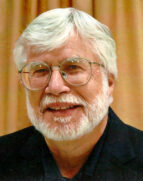
Richard Melzer
Biographer
Opinions expressed in this and all columns of La Historia del Rio Abajo are the author’s alone and not necessarily those of the Valencia County Historical Society or any other group or individual.)
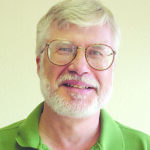
Richard Melzer, guest columnist
Richard Melzer, Ph.D., is a retired history professor who taught at The University of New Mexico–Valencia campus for more than 35 years. He has served on the board of directors of the Valencia County Historical Society for 30 years; he has served as the society’s president several times.
He has written many books and articles about New Mexico history, including many works on Valencia County, his favorite topic. His newest book, a biography of Casey Luna, was published in the spring of 2021.
Those interested in joining the Valencia County Historical Society should contact Dr. Melzer at [email protected].
